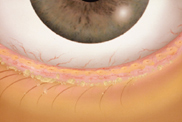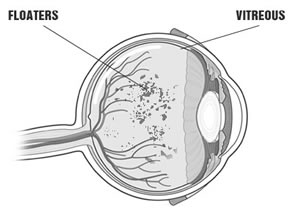

 Blepharitis is a chronic inflammation - a long-term swelling - of the eyelids and eyelash follicles. It may be caused by seborrheic dermatitis, acne, bacterial infection, allergic reaction or poor eyelid hygiene. The eyes may become red or blurry, as well as tear frequently. The eyelids crust, flake, scale or redden, and the smooth inside lining of the lids may become rough. In more serious cases, sores can form when the crusting skin is removed, the eyelashes may fall out, the eyelids can deform, the infection can spread to the cornea, and patients often suffer from excessive tearing. Blepharitis can also cause styes, chalazions and problems with the tear film.
Blepharitis is a chronic inflammation - a long-term swelling - of the eyelids and eyelash follicles. It may be caused by seborrheic dermatitis, acne, bacterial infection, allergic reaction or poor eyelid hygiene. The eyes may become red or blurry, as well as tear frequently. The eyelids crust, flake, scale or redden, and the smooth inside lining of the lids may become rough. In more serious cases, sores can form when the crusting skin is removed, the eyelashes may fall out, the eyelids can deform, the infection can spread to the cornea, and patients often suffer from excessive tearing. Blepharitis can also cause styes, chalazions and problems with the tear film.
Treatment and preventative care for blepharitis involves thorough but gentle cleaning of the eyelids, face and scalp. Warm compresses can be applied to loosen crust and dandruff shampoo can help keep the eyelids clear. This may be combined with antibiotics if a bacterial infection is causing or contributing to the problems.
Ectropion is a "turning out" of the eyelid that causes redness, irritation, tearing and an increased likelihood of infection. Common causes of ectropion include aging, sun damage, tumors, burns and the removal of too much skin during blepharoplasty. Artificial tears can help provide temporary relief from dryness. Ectropion can be corrected in a quick procedure in which the lid is tightened. Occasionally, the surgeon needs to graft a small segment of skin to ensure that the eyelid is fully repaired.
Entropion is a "turning in" of the eyelid. The lid and lashes rub painfully against the cornea. Entropion usually occurs as a result of aging, but other causes can include injury, congenital defect and various inflammatory conditions. A spasm can cause the lid to turn inward. Entropion can be corrected with a brief surgical procedure under local anesthesia.
 Although most flashes and floaters occur in people with healthy or merely nearsighted eyes, they can be symptoms of serious problems including injury and retinal and posterior vitreous detachments. Flashes in vision are caused by pressure on the retina, the bundle of nerves in the back of the eye where images are detected and transmitted to the brain. Patients complain of flashing lights or lightning streaks.
Although most flashes and floaters occur in people with healthy or merely nearsighted eyes, they can be symptoms of serious problems including injury and retinal and posterior vitreous detachments. Flashes in vision are caused by pressure on the retina, the bundle of nerves in the back of the eye where images are detected and transmitted to the brain. Patients complain of flashing lights or lightning streaks.
Floaters are often seen when fibers move within the vitreous humor, the gelatinous substance made of water and protein fibers that fills the eye. Patients complain of small specks or dots that can be seen against clear backgrounds. Serious vision loss can occur if the retina or vitreous detach from the eye wall. Patients experiencing flashes and floaters should contact their doctor immediately so an examination can be performed.
To learn more about these Eye Conditions and treatments and to find out if it is right for you, please call 718-638-2020 today to schedule a consultation.